
IPO is an organization of international accompaniment and communication working in solidarity with organizations that practice nonviolent resistance.
Where we work:
Artículos relacionados
3.06.10: Promotion and defense of human rights in the Rural workers reserve zone in the Cimitarra Valley
19.04.10: Humanitarian Refugee Camp Documentary
24.03.10: Grassroots Initiatives Challenge Water Privatization
12.03.10: Second Ecological Camp: Between fear and hope
17.02.10: Government officials withdraw from Negotiations with ASCAMCAT
8.10.09: New Farmers Organization Creates Alternatives to Forced Displacement
16.06.09: "We are tired of death": Letter to the special rapporteur on extrajudicial executions by the UN
13.06.09: Humanitarian Refugee Camp Declared in Catatumbo
6.06.09: A child dies, far from medical assistance
30.08.08: Education: It's not a lack of knowledge that's a stake, but a lack of power
otros...
15.04.12: Gallery of Remembrance Assaulted, Censored, and Threatened on April 9 in Villavicencio, Meta
18.02.12: Civilian dwellings in Agualinda bombed by the Army’s 4th Division
19.12.11: More Human Rights Violations in Huila
26.11.11: ASOCBAC Leader Fredy Jimenez Assassinated in Taraza
12.11.11: Member of CPDH held captive for 40 days
Topic Tree:
Ambiente
Alternative Comunication
Economia
Sindicatos
Comunidades indígenas
Coca
Comunidades campesinas
International Politic
Politica nacional
Justicia
Kidnapping
Parapolitica
Narcotrafico
Acuerdo Humanitario
Impunity
Ley de Justicia y Paz
Multinacionales y recursos naturales
Politica nacional
Acuerdo Humanitario
Narcotrafico
Parapolitica
Kidnapping
Armed Conflict
Paramilitarismo
FARC-EP
ELN
Plan Colombia
Vioations Human Rights
Positive Faults
Desplazamiento
Asesinados Políticos
Torture
Political Prisoners
Regions
Chocó
Tolima
Catatumbo
Meta
Periferias
Arauca
Magdalena Medio
Nord Est Antioquia
Sur de Bolivar
License

This work is licensed under
Creative Commons
PayPal
Backyard Battlefields in Filipinas, Arauca
27.06.08
By Dan Feder
International Peace Observatory
The village of Filipinas, Arauca must be one of the few places in the world where one can hear children’s laughter and machine-gun fire in the same instant. The giggling little girls running about around us had lived in a war zone long enough to know the sounds of combat are too far away to pose any real danger, and the looks of terror on the faces the adults visiting from far away are just hilarious to them.
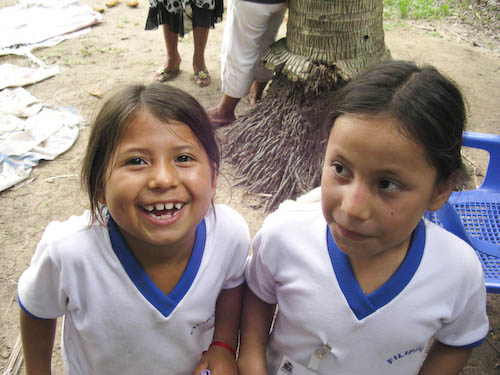
But the laughter masks a real fear and sadness. Filipinas and its surrounding villages and hamlets have been the scene of the worst fighting in the northeastern department of Arauca this year. I was in Filipinas from June 1-7, and saw firsthand a glimpse of what the unending war in this part of Colombia looks, feels and sounds like.
A small number of local residents and leaders had gathered from June 1-7 on a farm in Filipinas for a workshop put on by the Peasant Farmer Association of Arauca (ACA). ACA had invited a lawyer from the Humanidad Vigente legal collective and a group of social science students to speak on human rights and territory issues, an expert on organic agriculture from the national farmers’ union FENSUAGRO, and the International Peace Observatory to observe and provide accompaniment. It is through workshops like these and other organizing activities that ACA hopes to rebuild a social fabric torn apart by the years of conflict, and above all to encourage and help what remains of the rural population of Arauca to hold on to its land and resist being driven off.

Organic agriculture workshop in Filipinas
Each day of the workshop, the quiet of the endless crop fields and cattle pastures was occasionally broken by far-off helicopter engines. The rural area around Filipinas, part of the enormous municipality (county) of Tame, is one that the Colombian army considers the Revolutionary Armed Forces of Colombia’s (FARC’s) most important remaining stronghold in Arauca. There is constant military activity there. Predictably, the civilian population is constantly caught in the crossfire. This area, like most of Arauca, is part of Los Llanos, the vast tropical plain east of the Andes shared by Colombia and Venezuela. There are no mountains or valleys to isolate one town from another, as there are in most of the country’s Andean conflict zones. Everywhere feels exposed and vulnerable.
Heavy in the air still was the memory of the previous April 13, less than two months ago, when six men in camouflage entered Filipinas and grabbed two teenage boys, took them outside the village and killed them. The community was unable to identify what group the killers belonged to. In addition to the conflict between the army and the FARC, the FARC and National Liberation Army (ELN, Colombia’s other major rebel group) are also fighting each other over territory in Arauca, and Filipinas lies right on one of those fault lines. Rumors also fly of new rightwing and mafia groups emerging here, as they are across the country.
A similar event took place on May 11, with an unidentified armed group murdering farmer Luis Orlando Gelvez in the nearby village of Nuevo Oriente.
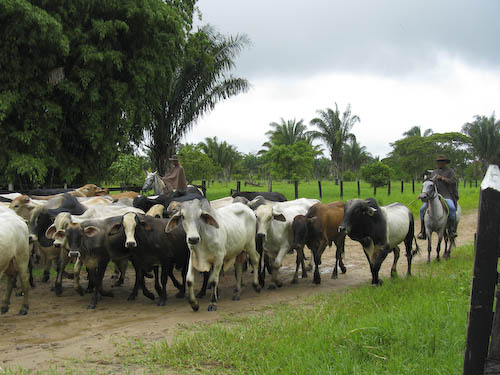
Arauca and Los Llanos known for their cowboy culture
On the afternoon of Thursday, June 5, we heard a number of loud, thunderous noises in the distance. People passing by the farm spoke of combat occurring the next town over. Soon afterwards, a helicopter passed high overhead, and as it flew away from us the unmistakable sound of machine-gun strafing began. People’s eyes grew wide, mothers clutched babies close, and everyone froze for a moment. When it became clear that no bullets were falling anywhere near us, the tension began to die down, children began laughing and pointing. Even some of the adults made nervous jokes, or gently teased those of us unaccustomed to being so close to such destructive force. But behind those anxious smiles, everyone is frightened. Maybe today, the shooting is far enough away that we can pretend it doesn’t matter. The strafing continued for over an hour, the bullets beginning to glow as the sun set and the sky quickly became dark.
The next day, we learned that the loud booms we had heard on Thursday afternoon were from combat between a small group of soldiers and guerrillas on a nearby farm. The soldiers, in a clear violation of International Humanitarian Law (the rules for respecting the civilian population during wartime, ratified by most countries in the world including Colombia), had been camped in a farmer’s house. This was not an isolated incident that we just happened to catch, but rather a constant problem and cause of fear throughout the country. Far from protecting the civilians, it brings the war right into their backyards and essentially puts them in the position of human shields for the soldiers.
As we drove out to the farm in a nearby village that morning to see what the damages were, we saw several houses with soldiers inside or immediately outside. At one point, three of them pointed and laughed at us. When we arrived, a single soldier was walking away from the site on the farm where an explosion had gone off, his finger on the trigger of his rifle.
Three cows lay bleeding in the middle of the field around a small blast hole. Two were dead, one still alive, breathing heavily, its side full of small holes from shrapnel. It had been lying there all night.
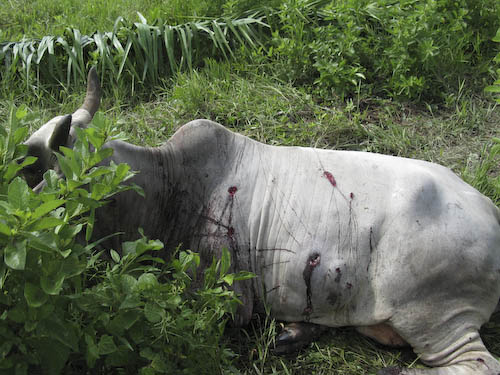
Each cow represents at least two months’ income for an Araucan farmer, and neighbors were furiously at work, helping the middle-aged woman who lived there to butcher the cows, trying to salvage what meat they could. She was home with a few family members when she saw the guerrillas charging to attack the small group of soldiers camped near her farm.
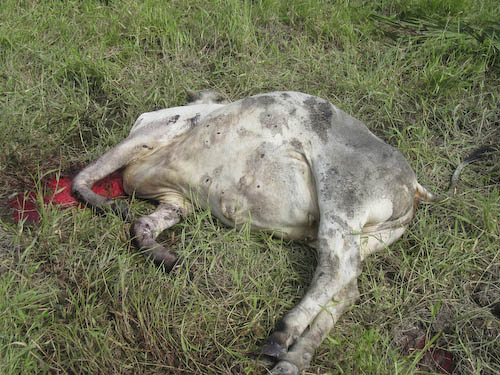
“I threw myself to the floor because there were lots of bullets coming through the house, so many of them,” she told us, her face growing more and more distraught as she spoke. “That’s the third time this has happened here. I threw myself to the floor and the bombs started to fall, they launched four of them. The last one was the one that got me, I felt the pain at once. Later a boy came by and told us about the animals.”
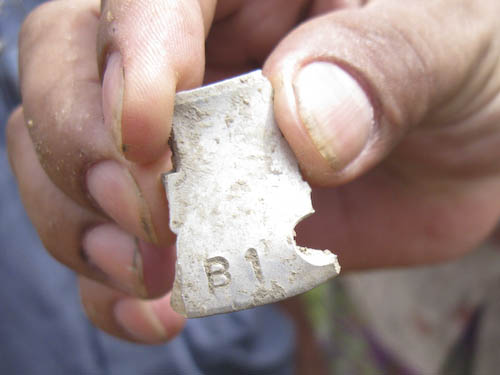
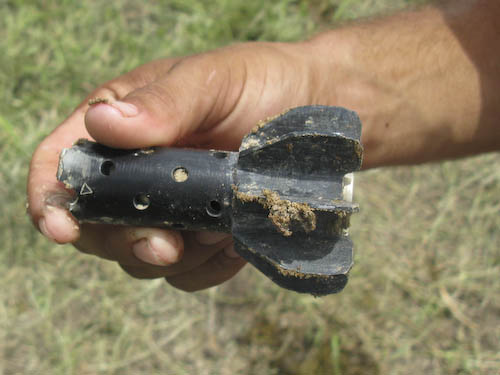
She was wondering out loud whether it made sense to stay on her land, whether she should just pack up and leave. In doing so, she would join the ranks of the more than 4 million displaced people in Colombia. In proportion to its population, Arauca was the Colombian department with the second-highest refugee problem in 2007.
In the shallow, meter-wide crater left by the lethal blast, we found a good part of the explosive device still intact. It was clearly not one of the guerrilla’s homemade “cylinder” bombs, but a small, industrially manufactured missile. One of the men there told me the soldiers fire these weapons from a handheld tube launcher; he has lived for years in the battlefield and I have no reason to doubt him.
And the soldier that we had just missed, walking out of the farm? I had assumed that he was that he was there to take down the woman’s information, fill out some kind of report, maybe even help her apply for compensation. But no: he had come by to see if, since the cows were already dead, she wouldn’t sell him and his comrades a bit of the meat.
We gave her a ride to the center of Filipinas, where a Doctors Without Borders mission happened to be visiting and could try to treat her for the pain she still felt in her abdomen after the explosion.
A village of survivors
“We came here displaced from where we used to live,” said José Luis Torres, a young man from Filipinas and member of the ACA, of his family’s experience. “We have been attacked by the state. There have been fire-fights in our house. But the goal is to continue, to keep on resisting, to keep living on this land, because it’s part of my life.”
José Luis was at his farm in the Tame village of Napoles on May 19, 2004, when a group of around 100 paramilitary fighters marched into the area (especially the neighboring town of Flor Amarillo) and massacred at least 13 civilians. José Luis says it was more: “They murdered 20 people, cutting off their heads and accusing them of being subversive collaborators. But they were just people, in many cases day laborers who came to work in the businesses in those towns. On May 20, I had to go with another boy down the road where the dead were, we were so shocked when we came across, one, then two, then three bodies.” There were military checkpoint on the same road, and few people believed the army’s story that they had nothing to do with the bloody paramilitary invasion.
Many people at the ACA workshop in Filipinas were witnesses or survivors of other traumatic moments in Arauca’s recent history. One woman had been living in Santo Domingo in December 1998, when the Colombian air force, working with two U.S. contractor pilots, dropped a cluster bomb into the town and killed 19 civilians. She still remembers the most intricate details of that day.
Some have been displaced many times, fleeing from town to town, even department to department every few years. One of the campesino movement’s biggest challenges is to break this cycle.
“It wouldn’t make sense to leave here, displaced,” says José Luis. “Why would we go to some city? There are people who go off looking for that because they believe that the city is going to solve all their problems, but it won’t. They may not suffer so much from the conflict, but they suffer from other things.”
But the army’s habit of staying in civilian homes and drawing the battles into their pastures continues, as does the violence. According to a series of communications from the ACA, on Sunday, June 8, the day after I had left, warplanes dropped a number of bombs near these towns. No serious damage was reported either, but these bombings are even more terrifying than the helicopter strafing, as they are far more destructive and less accurate (see Santo Domingo). On Monday, crop fumigations began in Filipinas, where there is hardly any coca, but lots of plantain and corn. A still-unknown number of crops were lost.
And on Tuesday, June 10, combat resumed and lasted most of the week. This included heavy mortar fire (explosive shells fired from a kilometer or more away) that fell very close to some houses.
A view from the offices
In a meeting a week later, Sandra Rangel, the Tame municipal personera (public defender), told us that the relationship between the military and civilians has changed remarkably in recent years. That people in general feel safe and protected by the army for the first time. But she did recognize that sometimes, in the more rural areas, the army can “forget” about Humanitarian Law and end up putting civilians even more at risk when they make camp for long periods of time in homes or schools. She claimed that her office was already taking measures to end this practice and that the results would soon be seen.
For his part, Brigadier General José Rafael González Villamil, commander of the Colombian Army’s 18th Brigade (and therefore in charge of all military activity in the department), insisted that such problems had ended years ago. “This year has been declared the year of strengthening human rights in the army,” he said in a meeting at his office in the departmental capital. “Our soldiers are no longer staying in houses or schools, we put a stop to that.”
Oneida Giraldo Camargo, the human rights lawyer who spoke to the farmers at the ACA workshop, had a bit to say about this special “human rights year” for the army, which has been widely publicized. The army talks about human rights, she explained, but never mentions International Humanitarian Law, because that would bring attention to the army’s constant violation of it. But in fact, as internationally understood, it is only the state, the government, that can guarantee human rights to its citizens. Human rights are not truly the army’s responsibility, while Humanitarian Law is.
But according to Gen. González, things are basically fine, and the people and the army are getting along just great. “This department is basically under control,” González told me. “We just have a few problemitas, a few little problems, down in Filipinas.” A few little problems, that’s all…
Photos by Dan Feder